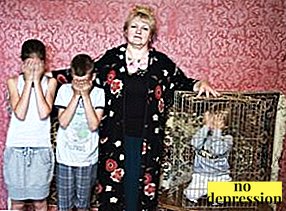Motive is that impulse, which helps a person to move in the direction of the goal, overcoming or avoiding intermediate obstacles.
A variety of motives and their manifestations can be observed in a detailed study of the motivational sphere.
Motivational sphere - what is it?

Every individual has his own individual combination needs, which determines the behavioral strategy.
The number and content of needs are formed depending on the lifestyle, living conditions, position in society, etc.
But need - This is an independent concept. And the satisfaction of needs can be considered only in conjunction with controlled behavior.
Those. need is a prerequisite for motivation, and motivation acts as a prerequisite for the formation of a set of actions aimed at satisfying needs.
Based on this formula, motivation can be viewed as a system of causes that determine individual behavior. And the sum of motivating reasons for activity (at different levels) forms a motivational sphere.
What is the motivational core?
Motivational core of personality - is a set of motives, connected by a semantic motive of activity.
It also serves as the main criterion in determining the type of motivation (the need for work, socially useful work, means of subsistence and status identification). Each of the 4 groups can be the basis of the motivational core.

The concept of "motivational sphere" and "motivational core" easy to confuse.
But the motivational sphere, in comparison with the motivational core, is broader concept.
While the core is only one of the components.
Psychology and features
The motivational sphere is the most important section of psychology, since motivation forms the individual's behavioral activity.
Motivational sphere has special features:
- flexible and plural;
- a wide range of different motives;
- availability of a classification system (hierarchical structure);
- the stability of the motives;
- impulsive power of motives;
- dynamic motives.
Multiplicity manifested in the increase and needs, and ways to meet these needs.

Flexibility Motivation is reflected in an infinite number of potential ways and means to meet identical needs.
Each individual person chooses the most optimal options from the totality of possible methods.
Hierarchy motives justified at the logical level, as a person consistently satisfies individual needs, moving from more significant (basic) to secondary.
The presence of structural division also logically justified, because one motive may include several needs. Thus, an organic motif combines the need for drinking, comfortable temperature conditions, etc.
Resilience implies a long preservation of motives even after individual needs are closed.
Only some quantitative or qualitative changes are possible, provoking improvements in the ways of satisfaction. If a person acts within the framework of a material motive, he will gradually desire more and more money or wealth.
Dynamic implies a change in the attitude of the individual to his own needs and the resulting change in the power and priority status of the motives.
B.M. Teplov singled out "short" and "far" motivationbased on considerations of perspective.

Motives of the "short" type apply only to the near future.
Well, long-range motives determine the strategy of long-term activity.
From what type of motive influences behavioral strategydepends on the attitude of the individual to the actions performed.
Sphere development
Scientist A.N. Leontyev laid the foundation for the study of the development of the motivational sphere in humans. He described in detail the mechanism for transforming a motive into a goal (key idea: in the process of carrying out activities, the desired goal is transformed into a motive force, replacing the motive).
Motivation is associated with the knowledge of the world and the formation of interests. And the first signs of interest can be traced to children under the age of one year old.
Thus, the motivational sphere begins to form in infancy.
Stages:
- Infant age. Activity is manifested in the form of emotions. Actions have an indicative and sensory-manipulative nature. During contact with parents and significant adults, the needs of the child grow, but the possibilities for satisfying them remain at the initial level.
- Early childhood. The kid studies and masters the world of things (the physical world), using the patterns of behavior accepted in society. Activity is subject-gun character.
- Preschool age. The development of the motivational sphere of a preschooler is associated with an awareness of the true meaning of human activity. The child is already trying to act in such a way that his actions were socially significant and could be assessed in society. There is a motivation to learn and master new skills in order to adapt to life. At the same time, the baby realizes that he is not sufficiently prepared for the development of the “adult world”.
- School age. The child tends to protect themselves from adults and willingly comes in contact with peers. Its activity is aimed at receiving and processing new information (knowledge). Intellectual and cognitive indicators are growing.
- Adolescence. The motivational sphere of adolescents is actively expanding. The individual focuses on intimate-personal communication.
Self-determination and the formation of moral ideals. The teenager is planning her future by acquiring new motives.
- Senior school age. The individual makes a choice in favor of leading activities, choosing from the options available in the social environment. The benchmark is a system of life meanings, fully formed by the time of graduation from school.


In the process of growing up, individual motives of behavior occupy the leading place and gradually turn into personality traits.
This may be the motive of rendering assistance, aggressive or constructive motives, the motive of avoiding responsibility, and so on.
So the value motivational sphere of the individual defines the personality itself, reflected in its inherent features.
Diagnostics
Diagnostics of the motivational sphere helps to determine the orientation of the individual and identify the true causes of actions.
Personality orientation is a sum of motives that are stable and independent of external conditions.
Quiz Test (TUV)
The technique is based on the principle thematic classification. A person undergoing a test assigns ambiguous stimuli a place in the individual classification, guided by apperception.
Phrases refer to different thematic constructors. The task is quite simple: combine the same phrases in the subject’s view under the label of the same topic.
For the test, a set of incentives is needed, consisting of 100 cards with humorous phrases. The test subject has 10 theme templates (4 cards for one topic). 60 phrases can be identified as “multi-valued”.
Those. the subject may have difficulty determining the topic, and will be forced to be guided by increased motivational significance topics

Topics:
- sadism;
- sexual relationships;
- addiction;
- finance;
- fashion;
- career;
- family problems;
- social problems;
- lack of talent;
- stupidity
In the original version of the methodology, the names of topics may differ from the list presented.
Study of the need for communication and achievements (software and PD method)
The technique is questionnaire, which includes 22 statements. The subject must mark each statement with the answer “yes” if his own opinion coincides with the statement. In case of inconsistency of opinions, the subject labels the statement with the answer “no”.
The allegations are of a generalized nature, so they should be considered outside of concrete situations and circumstances (based on a typical scenario of events).
Fill out the questionnaire should be consistent, without missing questions. Thinking time is limited.
Evaluation of the test occurs scoring methodassigned to the subject for each answer.
Direct diagnosis

The need-motivational sphere of the personality can be studied using direct diagnostics.
In this case, the specialist needs direct contact with the object of study.
An interview with topical questions allows you to accurately identify motives and interests, since the person is not limited to the standard questionnaire options or a set of incentives.
Projective techniques
To number most popular projective methods include TAT-method of G. Murray and the Rosenzweig test, methods of unfinished stories and sentences.
Adaptation and modification TAT test for the Russian-speaking population engaged in E.Т. Sokolova. In its variant, the stimulus materials consist of 20 tables, which in two sessions (ten units each) are presented individually to the subject.
The test results can determine the need for emotional interaction, success, avoidance of threats, etc.
The picturesque method of frustration Rosenzweig
Example:

The test is used in two forms: for children and adults. The essence of the method is that the subject analyzes the scene of interpersonal contact in the pictures and becomes familiar with the statement of one of the characters. After that, he gives an answer on behalf of the second character.
Diagnostics of the motivational sphere allows determine the true motives of man, understand the nature of his feelings, emotions and actions.
With this information, you can correct destructive behavioral strategies and achieve positive dynamics in any area of life.
The need-motivational sphere of the personality - the basic concepts:



